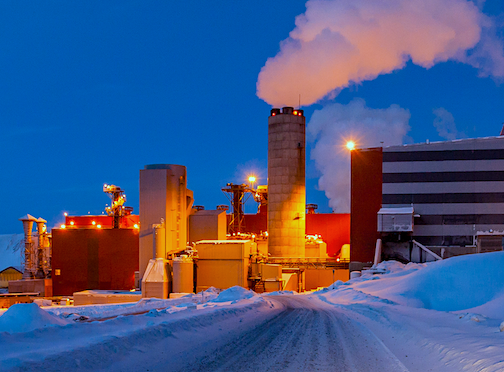Talking about the weather is a national pastime. It would appear we are obsessed with it. Yet, many maintenance organizations are often poorly positioned to deal with the problems that weather changes pose for their facilities and machinery, especially when cold temperatures and lubrication are involved.
Operations in northern regions are used to changing seasons and dealing with cold conditions that require a maintenance “shoulder season” to winterize buildings in the fall. This type of winterizing is aimed at ensuring fluid systems don’t freeze and snowfall doesn’t drift and restrict access to buildings and machinery. Facility maintenance planners have many set PM job tasks that deal specifically with winterization and spring readiness. But extremely cold weather often can deceive the most savvy planner or machine designer, particularly in regard to lubrication.
Lubricants are very susceptible to temperature change. As the temperature drops, oil/grease viscosity becomes thicker, making it difficult, and sometimes impossible, to pump to the bearing. That situation, in turn, creates a backpressure that stalls the lube pump until the temperature gets warmer and the oil becomes viscous again.
The following examples demonstrate three types of extreme-cold scenarios that have tricked many maintenance departments in northern regions.
CASE EXAMPLE #1
A building’s roof-top ventilation unit that takes in fresh air all year round requires regular greasing of its fan bearings. These components are typically lubricated with a standard NLGI #2 bearing grease. While that’s not a problem in summer months, winter weather adds a new dynamic when buildup of snow and ice makes it challenging to gain rooftop access. That lack of access can, and often does, result in missed lubrication applications and the probability of a shortened bearing lifecycles.
Savvy lubrication personnel may feel they can solve this type of problem by installing an automated single-point lubricator (SPL) that only requires attention once or twice a year, when moderate temperatures are more common. The strategy is an excellent one as long as the SPL unit will be filled with suitable NLGI #1 or NLGI #0 grease designed for use in very cold temperatures. An exception is found when synthetic-oil-based grease is used that will allow the use of NLGI #2 grease in much lower temperatures than similar non-synthetic counterparts.
The key here is to always read the grease specification sheet to ensure the product’s operating-temperature range suits your operating and temperature environment. If still unsure, be sure to contact your lubricant supplier to discuss the best grease for your specific application.
CASE EXAMPLE #2
A tire manufacturer employs an automated, dual-line lubrication system to simultaneously lubricate multiple tire making machines. When machines started to experience unusual repetitive bearing failures only in winter months, and the automated lube system appeared to be in full working order, the maintenance department was perplexed.
Further investigation revealed that the lube delivery system is served by a 40:1 pneumatic drum pump affixed to the top of a barrel of non-synthetic NLGI #2 grease, which allows a maximum pump pressure of 2000 psi at 100-psi line pressure. This pumping system also resides in an non-insulated outside walled room with broken windows and a non-functioning space heater. Twenty-four-hour monitoring revealed that the pump stalled continually in cold weather between the hours of 3:00 a.m. and 10:00 a.m. and, thus, pumped no lubricant, thanks to the grease thickening at lower temperatures.
The immediate fix required the installation of a thermostat-activated blanket heater wrapped around the barrel to heat the grease, independent of the repaired space heater.
CASE EXAMPLE #3
Similar to example #2, an automotive assembly line’s automatic oil conveyor lubricator, positioned high in the building roofline, started to mysteriously use less oil during cold weather than in the summer, and began experiencing premature bearing failures. Again, after further investigation, the pneumatic pump was found to stall for hours at a time during cold nights, despite the building being heated.
Because this situation involved an oil reservoir, the installation of a simple thermostat controlled automotive block heater in the reservoir solved the problem.
BOTTOM LINE
The conclusion from these three different, yet similar, examples is to make sure machine or plant designers are aware of intended working environments and temperature extremes in the design stage. This will ensure that the appropriate lubrication strategy and maintenance schedule can be recommended from the onset.
Planners also must exercise increased awareness of incomplete lubrication work due to cold-weather access, and failure of moving parts that occur seasonally during cold weather spells. With that awareness, heaters and trace lines can be installed/activated and lubricant viscosities can be changed out prior to onset of the cold season.TRR
ABOUT THE AUTHOR
Ken Bannister has 40+ years of experience in the RAM industry. For the past 30, he’s been a Managing Partner and Principal Asset Management Consultant with Engtech industries Inc., where he has specialized in helping clients implement best-practice asset-management programs worldwide. A founding member and past director of the Plant Engineering and Maintenance Association of Canada, he is the author of several books, including three on lubrication, one on predictive maintenance, and one on energy reduction strategies, and is currently writing one on planning and scheduling. Contact him directly at 519-469-9173 or kbannister@theramreview.com.
Tags: reliability, availability, maintenance, RAM, maintenance management, lubrication, oil, grease, automated lubrication systems, single-point lubrication systems, asset-management systems



